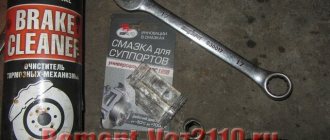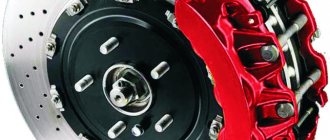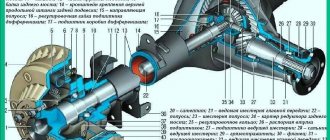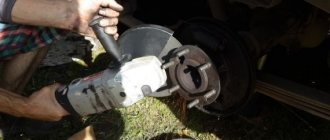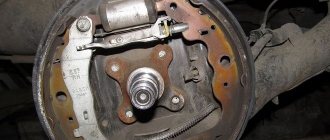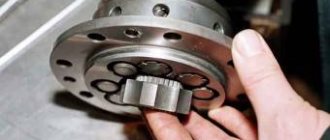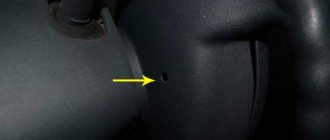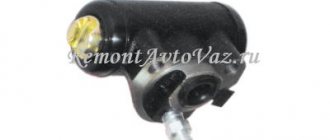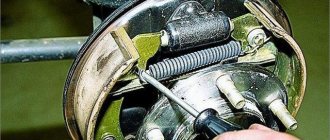Where is the front caliper of the VAZ 2107
On the “seven”, disc brakes are installed only on the front wheels.
The rear ones use a drum brake mechanism. Therefore, in the phrase “front caliper VAZ 2107” the word “front” is redundant. There are only two calipers and both of them are on the front wheels. Access to the brake calipers opens after dismantling the front wheels of the car.
- screwdriver or bit;
- keys for 17, 14 and 10;
- pliers;
- a piece of rubber tube or bolt with a diameter suitable for the inner diameter of the brake hose tip;
- marker.
It is necessary to remove and install the caliper when replacing it in case of deformation or damage. This is also a necessary action in order to repair the VAZ 2107 caliper.
To carry out the work, you must lift the car on a lift or use a jack. The latter option is somewhat more tedious, but ideal for home use.
Removing the brake caliper
To remove the caliper you must do the following:
- lift the car on a lift or jack up the wheel on which the brake caliper needs to be removed;
- Using a wrench, remove the bolt securing the brake hose bracket;
- remove the bracket so that it does not interfere with further actions;
Important: under the bracket fastening bolt there is a spring washer, which must not be lost when dismantling the bolt and bracket
- unscrew the bolt securing the brake hose;
- remove the bolt after first removing the two o-rings;
- insert a rubber tube or bolt of a suitable diameter into the hole in the brake hose tip to prevent brake fluid from leaking out;
- Use pliers to remove the cotter pins securing the brake pad pins;
- pull out the pins securing the brake pads and remove them using a bit or a thin, but not sharp, screwdriver;
- remove the retaining springs from the brake pads;
- remove the brake pads;
Advice: if you plan to use the brake pads in the future, they should be marked with a marker so that during reassembly they can be installed in the same place where they were. If this is not done, they will wear out faster and brake worse.
- bend the locking plates of the washers on the caliper mounting bolts;
- unscrew and remove the bolts securing the caliper to the steering knuckle;
- Remove the brake mechanism (caliper) of the VAZ 2107 from the brake disc.
Important: the upper and lower caliper mounting bolts differ in the shape of the head. When installing the unit in place, you must not mix them up.
Important points
When repairing the brake system of a VAZ 2107, you should remember several very important nuances. Without mentioning them, this article would be incomplete. So:
- On later VAZ 2107 models, spring washers began to be installed under the fastening bolts of the brake brackets. They are thin and very easy to lose when removing the bracket. To prevent this from happening, it is advisable to spread some newspaper or rag under the caliper. If the puck does pop out, it will be much easier to find it;
- If the driver does not plan to change the brake pads when replacing the caliper, then before removing them they should be marked with a marker or chalk so that they can be installed in the same place during reassembly. If you change the original location of the pads, they will become unusable much faster;
- If the driver decides to leave the caliper in place and plans to change only the brake pads, then he will have to buy not one, but two sets of pads, since these parts are always changed on two wheels, and not on one. If you leave old pads on one of the wheels, this will inevitably lead to rapid wear and new problems in the operation of the brake system;
So, replacing a brake caliper is not at all as difficult a task as it might seem at first glance. The main thing that the driver should remember when changing this part is its extreme importance. If a mistake is made when installing the caliper or pads, this does not bode well for either the driver or the car. It is for this reason that the article described in as much detail as possible all the nuances of installing a brake caliper. And it is strongly recommended to pay close attention to these nuances.
Repair of brake caliper VAZ 2107
A damaged or deformed brake caliper on a VAZ 2107 needs to be replaced. Caliper repair involves replacing faulty brake wheel cylinders. In some cases, instead of replacing the cylinders, they can be repaired.
The procedure for replacing cylinders is as follows:
- clamp the caliper in a vice;
- Unscrew the fittings of the connecting tube with a 10 mm wrench;
- remove the tube connecting the working cylinders;
- Use a hammer to knock out the working cylinders from the guides, after pressing the lock with a screwdriver;
- remove the clamps and replace them with new cylinders (if they are missing);
- insert the cylinders into the guides;
- install the connecting tube and tighten the fittings.
Repair of working cylinders consists of replacing the rubber sealing rings on the pistons. The order of operations is as follows:
- remove the brake cylinder;
- remove the protective cap from the piston using a screwdriver;
- apply compressed air to the cylinder to push the piston out;
- remove the sealing ring by prying it off with a screwdriver;
- install a new ring;
- lubricate the cylinder, piston and ring with brake fluid;
- insert the piston into the brake cylinder.
Important: before installing new sealing rings and assembling the cylinders, you must make sure that the inner surface of the cylinder and the piston are free of damage, cavities, and deformations. Otherwise, replace the brake cylinder with a new one.
Caliper (cylinder replacement)
- Answer
- Go to first unread message
#1 andreich1137
- Legends
- 2860 messages
- 1 thanks
- City: Vologda
- Car: VAZ-21074 injector
- Top
- Answer
- Quote
- Insert nickname or quote
#2 kuzma
Elvis Presley songwriter
- Kurgan city
- Car: VAZ21043,VAZ21093
- Top
- Answer
- Quote
- Insert nickname or quote
#3 Babus
- City 21053, Moscow,
A new caliper costs 300-400 rubles, it’s worth it. I’d rather install a new one, give my life for 300 rubles, nonsense.
- Top
- Answer
- Quote
- Insert nickname or quote
#4 andreich1137
- City: Vologda
- Car: VAZ-21074 injector
- Top
- Answer
- Quote
- Insert nickname or quote
#5 Babus
- City 21053, Moscow,
just need to buy the right one (right inner, right outer, left inner, left outer)
- Top
- Answer
- Quote
- Insert nickname or quote
#6 andreich1137
- City: Vologda
- Car: VAZ-21074 injector
- Top
- Answer
- Quote
- Insert nickname or quote
#7 Mijuello
- City 21140, Novomoskovsk (Tula region),
They are small pimples that are inserted into the hole on the top guide of the cylinder. Insert with the sharp end up, otherwise it will not fix. Then it will fit correctly into the slot on the caliper bracket. Be careful with the graphite guides, otherwise they will stick throughout life (aluminum-cast iron is a galvanic steam! :smile:)
- Top
- Answer
- Quote
- Insert nickname or quote
#8 andreich1137
- City: Vologda
- Car: VAZ-21074 injector
- Top
- Answer
- Quote
- Insert nickname or quote
#9 Mihuello
- City 21140, Novomoskovsk (Tula region),
- Top
- Answer
- Quote
- Insert nickname or quote
#10 andreich1137
- City: Vologda
- Car: VAZ-21074 injector
- Top
- Answer
- Quote
- Insert nickname or quote
#11 Mihuello
- City 21140, Novomoskovsk (Tula region),
- Top
- Answer
- Quote
- Insert nickname or quote
#12 andreich1137
- City: Vologda
- Car: VAZ-21074 injector
- Top
- Answer
- Quote
- Insert nickname or quote
#13 andreich1137
- City: Vologda
- Car: VAZ-21074 injector
take the new one and move on!
I cleaned the caliper itself from rust, especially in the runners where the cylinders are located,
and couldn't resist painting it
Having previously sealed the cylinder guides with masking tape
a couple of light blows with a hammer on the cylinder and the retainer is visible in the caliper slot
and finally a new caliper assembly
By the way, the connecting tube of the cylinders is not too bad, Mikha is right, you need to install it correctly
Installing the brake caliper
Installation of the brake caliper on the VAZ 2107 is carried out in the reverse order of its dismantling.
After installing the brake caliper, it is imperative to bleed the brake system, removing air from it. Until this operation is completed, operating the vehicle is strictly prohibited.
The left and right wheel calipers are slightly different, so you need to pay attention to this when purchasing new ones. After repairing and installing the VAZ 2107 brake caliper, it is necessary to check the brake system for fluid leaks and, if necessary, repair them
After repairing and installing the VAZ 2107 brake caliper, it is necessary to check the brake system for fluid leaks and, if necessary, repair them.
Price examples
When buying VAZ 2107 calipers, you should focus not only on their cost and equipment, but also on the manufacturer. Since the original caliper body is the last to be used after restoration, it is worth considering the removable cylinders, which are a functional element of the design, within the cost framework. High-quality and affordable prices include:
- Fenox, X4816C1 – 431 rub.
- Basalt, 2101-2107 – 390 rub.
- Autostandard, 21010-350118288 – 367 rub.
- Autostandard, 21010-350118388 – 372 rub.
- AT, 1182-001H (OE: 2101-3501182) – 412 rub.
- RIDER, 2101-3501180 – 510 rub.
- CEDAR, 2101-3501182 – 411 rub.
It is these models of external and internal caliper cylinders of the VAZ 2107 that are popular. This is due not only to the price, but also to the packaging, the presence of caps that fit the bleeder fittings, as well as a warranty of at least 3 months.
Replacing brake discs on a VAZ 2107
Before starting repair work, you should decide on the necessary tools and consumables. Here's what we need:
- set of open-end wrenches;
- a set of mounting blades;
- set of spanners;
- jack;
- flat screwdriver;
- a set of two new brake discs and four brake pads.
Sequence of work
First you will have to make several preparatory operations. The car is installed on a flat surface. The rear wheels are secured with shoes and a hand brake. The front wheel, on which the disc is planned to be replaced, is jacked up and removed.
- After removing the wheel, access to the brake disc becomes available. But it is held in place by a caliper with brake pads, which will have to be removed. First, use an open-end wrench to unscrew the bracket with the brake fluid supply hose.
- After removing the bolt, the bracket is moved to the side and the nut on the hose itself is unscrewed with an open-end wrench. The hose is disconnected, and the hole in it is plugged with a 17mm bolt or other plug of suitable size so that the brake fluid does not leak out of the system.
- Now you need to unscrew the two mounting bolts holding the caliper to the steering knuckle. After removing the bolts, the caliper is carefully removed from the brake disc.
- The brake caliper has been removed, and access to the brake disc mount is completely open. One of the 19 bolts holding the car wheel is screwed into the hole on the brake disc hub (this bolt is indicated by a blue arrow in the picture). After this, the mounting blade is installed as shown in the photo (by installing the blade in this way, it can be used as a lever and keep the brake disc from turning). With the other hand, unscrew a pair of mounting bolts on the brake disc ring.
- After removing the bolts, the mounting ring is removed, and then the brake disc itself is removed.
- The removed disc is replaced with a new one, then the VAZ 2107 brake system is reassembled.
How to determine brake pad wear
The question always arises of when to change the front brake pads; careless drivers begin to change them when they have worn down to metal, thereby creating a metallic squeak when braking.
And a good driver can easily determine the wear of the front brake pads by looking into the hole in the wheel disc, as shown in the photo below; if the pads are very worn, then the metal part of the brake pad will be very close to the brake disc, this is a sign that the brake pads need to be changed.
Photo. Visual inspection of the brake pads without removing the wheel.
Step-by-step process for replacing brake pads
After preparing all the tools, first measure the fluid level in the corresponding reservoir. The engine must be turned off. If the indicator is exceeded from the maximum, select some of the fluid so that nothing subsequently gets on the brake disc.
Raise the handbrake and place chocks under the wheels to prevent the car from rolling. Only now can you lift the car using a jack. Remove one wheel and clean the entire mechanism responsible for braking using a rag. If rust is visible, apply WD-40 for easy removal of the guides.
Unsplit the guides with thin-nose pliers
Place a drift in a convenient position and carefully knock out the guides (not completely) to the extent that the brake pads are freed
Remove the pressure springs from the pads. Now take pliers and use them to press the pistons into the cylinders. Once completed, you can remove the brake pad from the mechanism.
After dismantling the part, carry out an analytical inspection - determine the degree of production; if everything is normal, replacing it is a waste of time. The part can still continue to work out its service life, and the malfunction itself lies in a completely different functional unit of the car. If you determine the presence of wear, prepare a new pad for installation.
Take some grease and apply it to the guides. Be especially careful - the product should not come into contact with other functional components of the brake system.
To successfully install a new brake pad, all steps are performed in reverse order:
- Install the block.
- Install the springs.
- Reinstall the guides to secure the pad.
- Use thin-nose pliers to tighten the guides.
- Check that all mechanisms are secure, after which you can install the wheel.
- Lower the jack and remove the supports.
Once the procedure is complete, repeat the same with the other front wheel.
Once the pads are installed, start bleeding the brakes. To do this, simply press the corresponding pedal sharply several times. Then check the brake fluid level in the reservoir. If the level is lower than required, add the missing amount.
If you feel that you do not have enough experience to perform this work, contact a private workshop where a specialist will complete the work in a short time.
Parking system
Although it engages the mechanism of the rear axle wheels, it is in no way connected with the working mechanism. It uses a cable as a drive connected to the handbrake located inside the car.
Under the car, this cable is divided into two parts, going into the rear axle mechanisms. Inside, the ends of the cable are connected to the drive lever, which in turn is connected to a spacer bar. The drive lever is connected to one of the pads.
When the handbrake is engaged, the cable pulls the lever, and since it rests against the bar, the pads are released. The toothed sector of the handbrake fixes the position of the lever when the pads are spread apart.
Caliper jammed on the road: causes and symptoms
The caliper jams and fails due to overheating, dirt and moisture getting into it. There are also other provoking factors:
- Wear of the brake mechanism. This happens when the driver does not monitor the car parts and does not carry out timely diagnostic maintenance. The caliper becomes unusable and jams, often right on the road.
- Incorrect pad installation. When they are not parallel to the discs or in the wrong places due to an error during the repair, the brake mechanism jams.
- Lack of lubricant or incorrect selection. Typically, drivers try to save on lubrication, which is fraught with many problems. It is necessary to select a product that can reduce friction during the operation of parts and has cooling properties. High-quality lubrication should provide the mechanism with protection from exogenous adverse factors. Especially in winter, when the road is strewn with ice, snow, and stones.
When a caliper jams, it is accompanied by a number of characteristic symptoms:
- the discs become very hot, there is a burning smell in the cabin (these manifestations are typical for overheating of the brake mechanism parts);
- when you press the brake, the car pulls to the side (usually to the one where the jammed caliper is located);
- after releasing the brake pedal, a creaking sound is heard in the cabin - a sign of wear on a part of the brake system;
- brake fluid is heavily consumed;
- There are drops of oil visible on the wheel rim.
If the caliper jams on the road, the car may begin to brake on its own. This happens because the brake pads are in constant contact with the discs. As a result, the car will constantly brake, even when the driver does not touch the brake pedal. The pads will begin to deteriorate faster.
If even one of these phenomena is detected, it is important to take immediate measures - diagnose the brake system, level out the identified problems
Causes of jamming and creaking
Now directly about how to determine the presence of a problem.
The primary sign indicating a malfunction in the calipers of a car brake system is squeaking.
License plate frame with rear view camera: what they are, which one to buy
It is the creaking that indicates that the element is seriously worn out. In the near future, the unit must be replaced without fail, which the car literally and figuratively screams about. It is extremely difficult not to hear such a creak. But for some reason, thousands of motorists still stubbornly ignore it. As a result, they pay a rather high price. Sometimes even to the point of road accidents resulting from brake failure while driving. To prevent this, you need to understand the issue and understand the essence of what is happening.
The first step is to look at the possible causes. In fact, there are several potential problems to look for. Some of them arise due to the fault of the motorist, others are caused by the natural process of wear and tear.
In any case, the appearance of a squeak as a symptom is a harbinger that at the most inopportune moment the caliper may simply jam.
If you know the reasons, you can prevent them and troubleshoot them by contacting a car service center or solving the problem yourself.
The reasons are:
- The brake pads were initially installed incorrectly. As a result, they are not strictly parallel to the response drives. Because of this, creaking often appears;
- The brake discs are seriously worn out. The reasons are natural wear and tear and aggressive use of the car;
- There is no lubrication in the unit. Initially there was little of it, or it was used up;
- The lubricant was selected incorrectly. Many people skimp on lubricant intended for calipers, hence the consequences.
The most undesirable and dangerous situation is rightly considered when the piston does not return and the unit begins to jam during operation.
Imagine that you are driving a car, press the brake, and then accelerate again. But at the same time, the calipers do not release the front brakes. Additional resistance arises, the car tries to move, but cannot. The result is uncontrolled braking, extremely intense wear and serious overheating of the entire system.
Caliper device
Let's move on. The front axle mechanisms are disk ones, consisting of calipers with the main brake elements - pads, and brake discs.
A caliper is a body with cylinders made in it for the pistons. This model has two of them, one for each block. The support structure is shown in the figure.
The caliper pistons have the form of a glass, which is placed in their cylinders, but they can move along it. To prevent fluid leakage, the pistons are equipped with o-rings.
Pads are small metal plates onto which linings made of friction material are glued.
The brake disc is made of metal for better adhesion to the surface of the pads; its side surfaces are well processed so that there are no protrusions or shells on them.
The VAZ 2107 brakes work like this: the fluid moves into the caliper cylinders, where it begins to push out the pistons. They come out of the cylinders, pressing the pads against the disc.
dismantling the brake mechanism of the front wheel of a VAZ 2107
| The brake mechanism of the front wheel of a VAZ 2107 car consists of a brake caliper, brake wheel cylinders, a brake disc and brake pads. We remove the brake caliper of the front brake mechanism from the VAZ 2107 to replace it, replace the working cylinder or brake disc. The work is shown using the example of the brake mechanism of the right wheel of a VAZ 2107 car. To disassemble the brake mechanism of a VAZ 2107 car, you will need an assistant, as well as a special 10 mm wrench for brake pipes, a transparent vinyl tube of a suitable diameter, a container for draining brake fluid, fresh brake liquid (see “Operating fluids used on VAZ 2107 vehicles”). |
Removing the front wheel brake mechanism from a VAZ 2107 car
1. We prepare the VAZ 2107 car for operations (see “Preparation of the VAZ 2107 car for maintenance and repair”). 2. Remove the front wheel from the VAZ 2107 (see “Wheel of the VAZ 2107 - replacement”). 3. Remove the brake pads of the front wheel brake mechanism (see “Brake pads of the front wheels of the VAZ 2107 car - replacement”). 4. Disconnect the front wheel brake hose from the brake caliper (see “Front wheel brake hose of a VAZ 2107 - replacement”). 5. Using a chisel, bend the locking plate of the lower brake caliper mounting bolt (the lower brake caliper mounting bolt differs from the upper brake caliper mounting bolt in the presence of a spherical part). 6. Using a 17 mm socket wrench with an extension, unscrew the bolt of the lower brake caliper mounting. 7. Remove the brake caliper bolt along with the locking plate. 8. Similarly, unscrew the upper mounting bolt and remove the brake caliper assembly with the working brake cylinders from the VAZ 2107 car. The working brake cylinder of a VAZ 2107 must be replaced if the piston is jammed or if brake fluid leaks through the sealing ring. 9. Secure the brake caliper in a vice. 10. Using a 10 mm wrench, unscrew the two fittings securing the connecting tube of the working brake cylinders. 11. Remove the brake pipe. 12. Using a drift, press the spring-loaded clamp, while simultaneously knocking the brake cylinder out of the brake caliper along the guides.
Attention The brake cylinders of the front wheels of the VAZ 2107 are not interchangeable. Do not mix up brake cylinders when installing
2. Before installing a new brake cylinder, press the latch and install the brake cylinder into the guide grooves of the brake caliper.
Attention If it is difficult to install the new brake cylinder into the brake caliper, use a file to blunt the leading edge of the brake cylinder installation guide. 3
We press the brake cylinder until the latch engages. 4. Replace the copper sealing washers with new ones (see “Brake hose of the front wheel of a VAZ 2107 car - replacement”). 5. After installing the brake caliper on the VAZ 2107 car and connecting the brake hose, pump the brakes from the side of the replaced brake cylinder (see “Hydraulic brake drive of the VAZ 2107 car - pumping and replacing brake fluid”)
3. Press in the brake cylinder until the latch engages. 4. Replace the copper sealing washers with new ones (see “Brake hose of the front wheel of a VAZ 2107 car - replacement”). 5. After installing the brake caliper on the VAZ 2107 car and connecting the brake hose, pump the brakes from the side of the replaced brake cylinder (see “Hydraulic brake drive of the VAZ 2107 car - pumping and replacing brake fluid”).
Attention We replace brake discs in pairs on both sides of the VAZ 2107 car. Periodically check the condition of the brake discs (see
“Brake system of the VAZ 2107 car - checking the technical condition”) and replace the brake discs when worn, avoiding wear of the brake discs to a thickness of less than 9.5 mm, with increased lateral runout or in the case of deep scratches on the working surface.
Repair of brakes, calipers VAZ 2101, 2106, 2107 CLASSICS
Installation of front brakes from VAZ 2110-12 on VAZ Classic
Having gone through the procedure of replacing the brakes on my car, I would like to share my experience and advice with those who are just planning to perform such an operation. Let me remind you that the brake mechanisms of the VAZ 2110 are designed for 13′ brake and wheel discs, while the mechanisms of the VAZ 2112 are designed only for 14′ discs. Since I have both sets of 13′ wheels, the choice fell on the VAZ 2110 brakes. Let's start with the reasons. The main one is braking efficiency, especially from high speeds (about 110 km/h). It’s no secret to any of the owners of the Classic that the standard brakes are enough for two or three powerful emergency braking from decent speeds, after which you can safely go to the store for new discs, because the old ones are caused by overheating. Ventilated brake discs allow you to use your brakes without thinking about how hard they are working. Another reason is the ease of maintenance of the 2110-12 calipers; changing pads is a pleasure, plus the ability to install squeaks on the pads, which will help you remember to replace them in time. Well, for now the last reason, which was a pleasant bonus: the caliper with the VAZ 2110 disc to the touch weighs 4 kilograms less than the original brakes. Already when leaving work, I felt that the front suspension began to work out more little things and, in general, work more softly. Actually, let's move on to the procedure for purchasing and installing brakes. Purchase
To install a set of VAZ 2110 brakes on a classic, you need to buy:
A set of adapters (2 pieces)
for installation on the front axle of the Classic calipers VAZ 2108-10-12, like these:
Brake discs VAZ 2110
, I opted for wheels in the Lada-Sport package - ventilated, perforated, with grooves. Upon closer inspection, the disks turned out to be manufactured by , which has established itself as a manufacturer of high-quality components.
I highly recommend purchasing in advance all the fasteners for the steering knuckles and bipods, as well as the steering bipods themselves (in stores they are listed under the name “steering knuckle lever VAZ 2101-07”). The long bolts soured in the bipods so much that I couldn’t knock them out or drill them out, so in the end I replaced both bipods; they were also purchased at the Rus-Trade store. I fastened the caliper to the adapter using the bolts for fastening the ball joints of a VAZ 2108 (there were a lot of new ones lying around at work, they have 16 turnkey hats, they come with a grower). Depending on the condition of the wheel bearings and hub seals, they can also be replaced; the hub will still need to be removed during installation. Installation
The installation should begin with the fact that under the hood of the car you need to tightly clamp the hose that goes from the brake fluid reservoir to the piston of the front circuit of the main brake cylinder (there are two of them, we need the one that is closer to the engine shield, i.e. the rear one in the direction auto).
This must be done to avoid severe airing of the circuits after removing the original calipers and hoses. It is very convenient to use a medical clamp with a lock for this; if you don’t have one at hand, you can get by with thin-nose pliers/pliers, repeatedly wrapping their handles with increasing force with a tight rubber band or rope. Next, we dismantle the original brakes, there are no difficulties here - we unscrew the caliper from the knuckle, then the brake hose, remove the brake disc, and, unscrewing the hub nut (it’s better to loosen them with a sharp bit before doing this, you won’t spoil the threads and you don’t have to buy new nuts), remove the hubs . Attention!
The thread on the right hub nut is right-handed, i.e.
the nut is unscrewed clockwise
. Next comes the most difficult part - you need to unscrew the original caliper adapter and bipod from the fist. On the one hand, I tried to unscrew them, the short bolts came out without any problems, but the long ones that hold the bipod were a problem. If you have access to an angle grinder, cut them down immediately, saving a lot of time and nerves. Another option is to drill out the caps. They come out of the caliper adapter and knuckle normally, but you don’t even have to try from the bipod. I forgot to say, the steering ends will also have to be removed, who knows what, I used the Force universal ball joint remover and a pneumatic impact wrench. The main thing is not to spoil the carvings on your fingers. It is better to do the next operation in advance. Back at home, having attached the adapters to the 2110 calipers, I saw that the adapters would have to be sharpened from the side of the brake cylinder, otherwise one mounting hole would not match. This is clearly visible in the photo:
After filing with a grinder along the intended lines, you should end up with something like this:
After this you can start assembling
. Thoroughly clean the mating surface of the knuckle from rust with an iron brush. During the assembly process, I highly recommend lubricating all mating surfaces and bolts with any grease (litol, CV joint, etc.) to avoid souring and to facilitate future disassembly of the assembly, if necessary. I used universal high-temperature lithium grease from MS
We install the adapter on the fist (do not confuse the right with the left), the bipod, and tighten all the bolts properly. You can ignore the fact that one edge of the head of the original bolts is ground off so that it does not touch the hub; nothing touches me with ordinary heads. We tighten the wheel nut by hand; adjusting the bearing clearance will need to be done at the very end, with the wheel installed.
We install the brake disc (if they are not standard, do not confuse the right with the left), and the caliper:
Next, we connect the hydraulics and pump the brakes according to the standard scheme. On the other hand, we repeat all operations. After installing the wheels, it is necessary to adjust the thermal clearance of the wheel bearings. There is nothing complicated in this procedure, the information is on the Internet, just in case, I’ll tell you how I do it. The bearing is slowly tightened until you can no longer feel the play of the wheel along the vertical axis with your hands (we shake the wheel by holding it with your hands at 12 and 6 o’clock), after which the nut is unscrewed by 10 degrees. This will provide the necessary thermal clearance for normal operation of the bearing. We lock the nuts with a sharpened beard. Don't forget, the thread on the right nut is right-hand, the nut is screwed counterclockwise. That's all. We drive and enjoy the work of the new system.
Even if they are not ground in, with crappy standard pads they brake a little better than the original brakes, I can imagine what will happen with the ground in TRW pads. And one more thing that will need to be corrected is the dangerous proximity of the brake hoses to the levers, this is clearly visible in the photographs, a little later I’m thinking of putting back the standard hoses, or coming up with some kind of fasteners for these to avoid chafing with the levers. Well, due to the replacement of the bipod, the toe-in was slightly out of whack, so we'll have to go to a wheel alignment.
Removal and repair of front calipers on VAZ 2101 (front brakes)
I noticed that when the car sits overnight after a trip, you can barely move it at normal engine speeds. I had to change the throttle and “rip off” the wheels, so to speak. I didn’t sin on the rear wheels, since I recently changed the pads and adjusted them more or less normally. But there is some kind of problem with the front brakes. Even when I got “wheels,” the first and second thing I did was change the running gear consumables and the front pads (the rear ones were still intact at that time). 3 years have passed and the problem has not gone away. So, vacation has arrived, a convenient moment to implement our ideas and off we go... The first thing we need is TOOLS, namely: a jack, a wheel wrench, keys for 10, 14 (many have 13) and 17 and, if available, the same heads, screwdriver, pliers , a hammer, a split wrench for pipes, a stationary vice, some kind of container for collecting parts. What I didn't indicate, look at the photos.
Tool used for removing front calipers on VAZ 2101
Parts: Brake fluid (1l, but less can be done), repair kit for front brake cylinders
I also had a Soviet set, but in the same quantity
If you decide to replace the brake cylinders completely, it is advisable to change them in pairs (internal + external). Let's start with... Jack up the wheel, turn it by hand and at the same time check for play in the bearings (it won't hurt)
Remove the wheel and see the following picture
We have a hub, caliper, hoses, etc.
Unscrew the bolt securing the brake hose bracket to the caliper and remove the bracket.
We unscrew the bolt securing the brake hose and remove it with the upper sealing washer and the brake hose. You need to be careful here, because the second (lower) sealing washer remains on the brake cylinder. Don’t lose it, otherwise you will have to look for it in your hardware, because you can’t live without it. As soon as you start unscrewing this bolt, brake fluid will begin to ooze from under it, and only the degree of your skill will determine how much brake fluid you will then have to add to the reservoir. When you unscrew and remove the bolt from the hose, the hole will need to be closed with something (for example, a piece of rubber from a camera twisted into a cone did the job perfectly). So, the hole was plugged, the removed parts were put in one place and the copper washer was not lost. Remove two cotter pins from the fingers; we knock out the fingers from the brake cylinders; remove the brake pad pressure springs and take them out.
If they do not give in, and in most cases with jammed brakes this is the case, then a hammer, punch or something similar comes to the rescue and carefully knock out the pads. By the way, the pads may be prevented from coming out by the shoulder on the disc formed by the wear of the pads.
It's time to unscrew the two caliper mounting bolts. I read several manuals that write about lock washers, but I didn’t see (or feel) anything other than the Grover (which is essentially a lock washer anyway). We take the key (head and knob) 17 in our hands and boldly unscrew it with Virastyuk’s effort
This is the end of removing the caliper. By the way, without pads, the brake disc spins very happily!
Installing the caliper is the reverse of removing it, so there shouldn't be any problems. But I had an embarrassment - the batteries on the camera ran out, so no further photo accompaniment. We take the removed caliper and first go to a convenient place to remove the connecting line, and then to the vice along the way, grabbing a hammer and a wooden block (after all, it’s aluminum, it’s a pity). Here you need to remember about the retainer, which rests on each cylinder and can be seen by the slot in the caliper body. And it rests with me because everything is covered with dirt and after pressing it once, it never returned to its place. It's okay, we'll fix it. The main line can also become sour and not succumb to provocations, so you should consider purchasing spare ones. First, we fix one side of the caliper, and on the other we knock out the brake cylinder and remember and mark the side from which it was removed. We repeat the same procedure with the other brake cylinder. Having examined the removed cylinders, I fell into a stupor. How to pull out the pressure cylinder itself. and came to the conclusion that you need to connect it back to the brake hose and pump the brake pedal several times and it will come out of the housing. This is how it happened, but the main thing here is not to overdo it, because you can lose a lot of brake fluid, which is what happened on my first sampler. That's why you need 1 liter of liquid))). I did the same with the other cylinder, only I screwed the plugged tube from the line (lying around in the parts) into the adjacent hole. Now we carefully wipe them and diagnose them. I got by with a small scrape of oxidized aluminum on the edges with a knife and that’s it. For each cylinder there is one oil seal, which is placed inside the housing, and one boot - tensioned after installing the pressure cylinder in place. Before installation, coat everything in brake fluid and assemble it. I’ll say right away that the pressure cylinder is very bad, it almost doesn’t fit into the body, so it needs to be driven in with a hammer at both ends at the same time (I hope you’ll understand).
I forgot to mention the retainer. I pulled it out, blew out the hole with lung air, lubricated it with lithol and put it back. We put everything back together, and then back again, install it on the car and pump this wheel. There is no point in pumping other wheels, since the sorcerer (force distributor) did not allow air to enter the rear cylinders.
Installing VAZ 2112 brakes on a VAZ classic
I am posting a manual for installing VAZ 2112 brakes on a classic.
Necessary tools and small parts
7mm wrenches - unscrew the studs, 8mm - bleed the brakes, 13mm - install the pads in the new caliper, 14mm - unscrew the old brake hose from the old caliper and screw it to the new one, 15mm wrench - remove the brake hose from the VAZ 2112 caliper - provided that it is attached there, wrench 17mm head + ratchet and standard, 27 mm - socket or head.
Washers for the brake hose - 4 pcs., long bolts for fastening the washers plan 99% that the original ones are attached - 4 pcs. That's all. Litol - 24 and brake fluid.
So, the list of stages and sequence:
1. Remove the wheel - 4 unscrew the 4 bolts. 2. Remove the original 13″ caliper - without unscrewing the brake fluid hose
held on by 2 17mm bolts
caliper mounting points
3. Remove the 13″ brake disc along with the hub - 1 nut per 27mm, having previously unscrewed the studs. 4. Remove the original faceplate, along with the boot - 4 17mm bolts
Further about the stages of assembly and what needs to be done first: 1. You need to take metal scissors or a grinder to cut the boot - just like in the photo and straighten it with a hammer. Otherwise the 14″ disk will not fit.
Please pay attention to where else it is necessary to cut the boot so that the new caliper can easily fit into its seats. Cut only for installing the caliper.
2. We fasten the new faceplate (you can see how to install it in the figure above), I warn you, do not forget to insert the lower bolt into the new faceplate, otherwise the lever simply will not allow you to install it later, and I also advise you to install the upper bolt there instead of the lower one with a flat head, and not round
together with the boot also 4 bolts back, it is impossible to confuse the installation locations of long and short bolts). The only thing I draw attention to is the need to install brackets to firmly secure the bolts and nuts from loosening.
3. You must first grind off the small protrusion on the hub in a circle in any convenient way, otherwise the brake disc will not fit, see the photo, you can clearly see where to grind
4. Install the new disc back onto the hub. Sharpen the hub better - otherwise you will have ABS to check whether the disc is level. We put it on the hub without pulling it and try to swing it from side to side, if there is any play, then we continue sharpening
tighten with studs and twist; also check for evenness of rotation, do not overtighten the hub! It’s better to tighten it to the same riveted places on the nut and rivet them again. 5. We put pads into the brake caliper and put them on top of the disc, fix the caliper with 2 bolts). Once again we check for smooth rotation - runout of less than 0.2 mm is allowed... 6. Unscrew the brake hose from the old brake caliper - 14 mm nut. Take new bronze washers and attach the original hose from the VAZ 2101 or a new one to the new caliper. This is so that the main brake does not catch air and the loss of brake fluid is minimal. The nut is marked in the photo
7. Bleeding the brakes, preferably all circuits.
Here is the finished result:
From force majeure: I had to replace one hub (the thread on one of the bolts was eaten up); the disk and tires were held on by three bolts and a new internal boot was attached to it. I’m sharing my first impressions, the new brakes are starting to gain momentum, the pads are being quickly ground in, their effectiveness is starting to increase, but I feel that maximum aggression is yet to come.
Useful drawings for installing VAZ 2112 calipers in a VAZ 2107
And this is my drawing.
Here are some drawings that might be useful to someone.
https://www.drive2.ru/l/3010828/, https://www.drive2.ru/l/5668721/, https://www.drive2.ru/l/288230376152186883/, https://www .drive2.ru/l/925982/
next article:
Parking brake (handbrake) VAZ 2101, 2106, 2107 classic
Contents of the article: Installing a hydraulic handbrake on a VAZ 2101. Sound signaling device for the parking brake (handbrake) on a VAZ 2103 1.
Rating 0.00 [0 Vote(s)]
How often should you change front pads?
Let's start with the fact that on the VAZ 2107 the front brakes are represented by a disc system, which in some ways is much better than a drum one, but that’s not about that now. There are 2 pads on each caliper at the front, which are responsible for effective braking of the car. The front brake pads of the VAZ 2107 have the following appearance, shown in the photo above.
Essentially, the products are a steel plate onto which a special friction layer is applied. It is this friction layer that is the basis for car braking. When this layer wears off, which depends not only on the frequency of use of the brake pedal, but also on the nature of driving, then the car owner urgently needs to replace the brake pads on the VAZ 2107. If this is not done in a timely manner, then you understand what the outcome may be.
How often it is necessary to change the parts in question depends on the following factors:
- condition of the brake system;
- character and driving habits;
- product manufacturer;
- regular maintenance.
But our mentality is such that we don’t pay attention to how often we need to change the pads, and we do it when it’s pressing. The reasons that indicate that the car requires repair work on the brake system are due to the following symptoms:
- the appearance of extraneous sounds when you press the brake pedal: creaking or grinding;
- to brake, you need to apply force;
- When braking, the car begins to skid.
Approximately, it is necessary to replace the front pads on a car every 25-30 thousand km. But this range is average, since someone can travel 50 thousand km without replacing products, but they can only do 10. Let’s look at what it is to replace the front brake pads of a VAZ 2107 in more detail.
Detailed description of replacing front pads on a VAZ 2107
Replacing pads on a VAZ 2107 is a simple process that needs to be taken seriously. First you need to purchase new products. You need to buy them as a set, and replacement should be done on both wheels at once. After this, make sure that you have a basic list of tools:
- screwdriver;
- hammer and chisel;
- pliers;
- standard set of wrenches;
- WD-40 lubricant;
- Brake Cleaner (optional).
Let's start the workflow:
- Initially, some of the fluid should be removed from the brake reservoir, which is done to prevent it from overflowing and entering the engine compartment.
- Place shoes under the wheels, then install a jack and lift the front end. Afterwards, the wheel is removed, and then the surface of the caliper is cleaned of dirt and dust.
- Using a thin screwdriver, remove the two visible cotter pins. These cotter pins are designed to hold the pad rods. The photo below shows the location of these two cotter pins.
- Using a screwdriver, you need to press out the pad rods. If your own efforts are not enough, then you can use a hammer and a punch.
- The products are additionally held by spring structures, which can be seen in the photo above. They also need to be dismantled, for which you need to use pliers.
- When the rods and springs are removed, you can begin to dismantle the products themselves. Usually the pads do not sit tightly, so you just need to pry them off with a screwdriver and remove them, as shown in the photo below.
- Once the pads are removed, it is recommended to clean the seat using special products, and you can begin installing new ones.
- To do this, using a mounting tool or a screwdriver, you need to separate both cylinders, thereby preparing a place for new (thicker) pads. At the same time, do not forget to monitor the level of the displaced liquid in the barrel and, if necessary, remove it.
After installing the new products in their places, install the rods and mounting springs in the reverse order. This completes the replacement of the front pads on the popular VAZ 2107 car. As you can see, there is nothing complicated at all. Everything is simple and clear, but the main thing is to perform all the steps in the order described above. After installing new system elements according to the instructions, there is no need to bleed the brakes.
If you decide to replace worn-out products, then it is recommended to purchase new ones from companies such as Ferodo, ATE or Nippon. They will last much longer and will also delight you with their quality and braking performance. If you still don’t know how to change the front brake pads on a Zhiguli, then this material will be a good help. And remember that you will always have time to overpay the mechanic at the service station, but only then will you not be able to gain invaluable experience in repairing your car.
Basic faults
The brake system itself is quite simple, but some of its elements require special attention. Main types of faults:
- The brake fluid leaks, resulting in a drop in pressure in the system. If a preliminary inspection does not find a leak, it is necessary to check the brake master cylinder. We bend the noise-insulating mat located under the brake pedal and inspect for streaks in the area of the rubber seal of the master cylinder. The presence of drips will indicate that the cause has been found and requires disassembling the cylinder and then replacing the cuff. If there is a vacuum booster, the brake master cylinder must be removed and inspected.
- When you release the brake pedal, the car drives sluggishly. Reason: the rear or front pads are jammed. Seized pads are identified by checking the heat of the corresponding wheel. We touch each disk - the hottest one will be jammed. In the case when these are the front wheels, you can, after removing the wheel, move the brake cylinder. If this fails, you will have to replace it with a new one. In the case of rear pads, the brake wheel cylinder will need to be replaced.
- When you press the pedal, braking does not occur, but it does when you press it several times in a row. This may indicate the presence of air in the system. The solution to the problem is to bleed the brakes to remove air.
- Problem with the handbrake. Most often this problem occurs in winter. It manifests itself in the fact that after a long period of parking, when the handbrake is released, the wheels remain locked. The reason is that the parking brake cable is frozen. During its operation, moisture gets there and freezes in winter. If the casing is severely damaged, it will have to be replaced.
Read, it might come in handy: Which shock absorbers to choose for a car?
Brake master cylinder diagram
Vibration when braking
This is a fairly common malfunction that is associated solely with critical or uneven wear of the discs or drums, and the repair will consist of replacing them.
Car shifts to the side when braking
The malfunction is due to either a failure of the working (wheel) cylinder or wear of the pads. Replacing them (or repairing them) will solve the problem.
The VAZ 2107 brake pedal fails: the main reasons
The brake system must be sealed and free of air. If the pedal begins to fail, then, with a greater degree of probability, we can say that depressurization has occurred, that is, air has entered the system.
Other reasons:
- rust formation on the pedal linkage;
- failure of the vacuum booster;
- unadjusted distance between the cylinder piston and the pedal itself;
- lack of fuel fluid in the system.
It is also important to remember that brake fluid is an aggressive substance that can destroy thin pipes and even lines. That is why it is important to use only high-quality TZ. Low-quality liquid can form cracks through which it then flows out safely. But the flip side of the coin is that when you press the brake pedal, air leaks through these cracks.
Vacuum brake booster
A rod connected to the amplifier is connected to the pedal. The design of the VAZ-2107 vacuum brake booster is quite interesting; it is shown in the figure:
The amplifier is a sealed container, internally divided into 2 chambers by means of a membrane. The chamber located closer to the pedal is called atmospheric, and the chamber separated from it by a membrane is called vacuum. The diaphragm itself is connected to the piston rod of the master cylinder.
The vacuum chamber is connected by a pipe to the intake manifold of the engine, where the vacuum comes from. The design also includes a follower valve controlled by the pedal rod, which does all the work.
When the pedal is released, this valve connects the chamber cavities through a channel, providing identical pressure. When the pedal is applied, the valve closes the channel connecting the chambers and opens the channel connecting the atmospheric chamber with the atmosphere. Since a vacuum is maintained in the second chamber, atmospheric pressure begins to put pressure on the membrane. Since it is connected to the piston rod of the master cylinder, due to the movement of the piston, fluid is displaced from the cylinder into the pipelines.
Master brake cylinder VAZ 2107
A fully operational brake system of a VAZ 2107 car is a key element in ensuring safe movement in a car for both passengers and the driver.
Therefore, you should pay special attention to it, and if minor signs of malfunction appear, begin repairs immediately.
The brake master cylinder is one of the main elements of the car's braking system. Basically it can have two faults. The first is the appearance of a fluid leak from the main brake, the second is a decrease in the effectiveness of the brakes, which can be determined by the failure of the pedal or its “softness”. Both of these faults can be eliminated by a not very complicated repair of the main brake; this repair consists of replacing the o-rings and boot, but in some cases the problem can only be solved by replacing the cylinder.
- How does the brake master cylinder work?
- Removal and repair
- Repair of the VAZ master brake cylinder: Video
